11 Types of Duck Found in Massachusetts (With Pictures)
Last Updated on
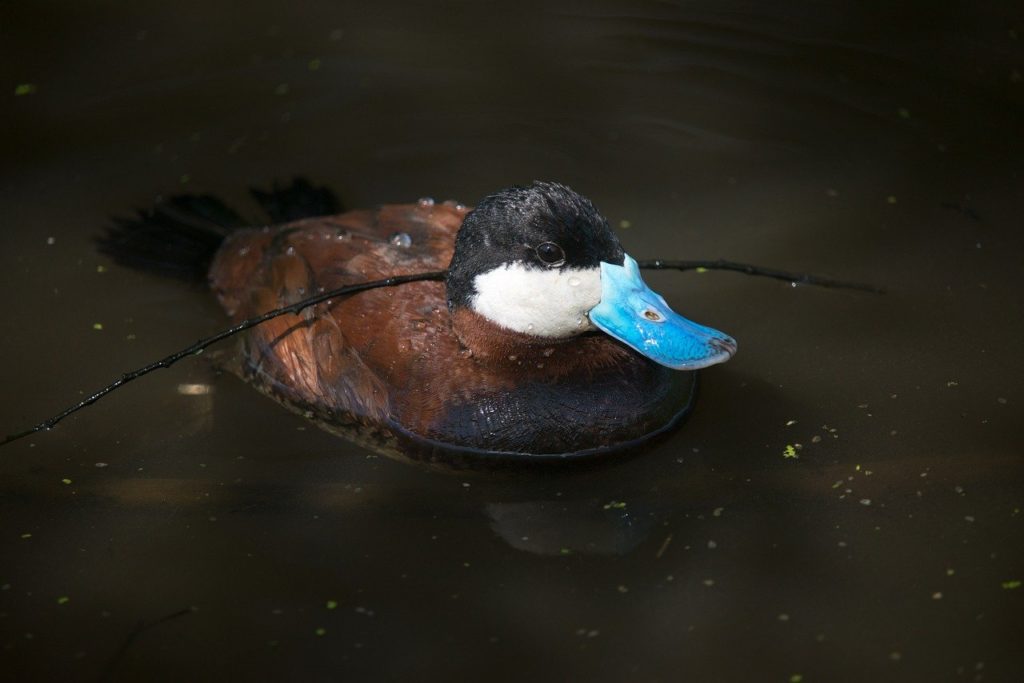
Ducks are one of the most commonly seen aquatic animals. If you go to any pond or lake, you are bound to see a few. Most people are familiar with one or two duck breeds, but there is an astonishing variety of different species of duck that you may find across Massachusetts.
To better understand the types of duck that we might find in Massachusetts, we must first understand more about ducks. Unbeknownst to most people, there are two different types of ducks: dabbling ducks and diving ducks. The two ducks have different physical features because they have different diets and hunting methods.
Here are just 10 duck breeds you may see when birdwatching in Massachusetts.

The 11 Duck Breeds Found in Massachusetts
Dabbling Ducks
Dabbling ducks stick their head under the water leaving their tail in the air to feed on plants and invertebrates in the shallow waters. They rarely, if ever, submerge the whole body and swim underwater. Their great wings are more rounded and more prominent to allow them to take off from the water surface. As winter ends, they may feed on vegetation and discarded grains on farms.
1. Mallard

Mallards are the most common species of duck in Massachusetts. Almost everybody in Massachusetts is familiar with the green head of the male Mallard duck. Female Mallard ducks have mottled brown coloring with orange and brown beaks. Both sexes have purple and blue secondary feathers primarily seen when standing or flying.
Mallard ducks are common all over North America; they’re found in almost every wetland environment on the continent. They’re also pretty friendly; they will readily accept artificial structures designed for them. So, if you have a pond in your backyard, feel free to build a little hideaway for the Mallard ducks that may nest there.
2. American Wigeon
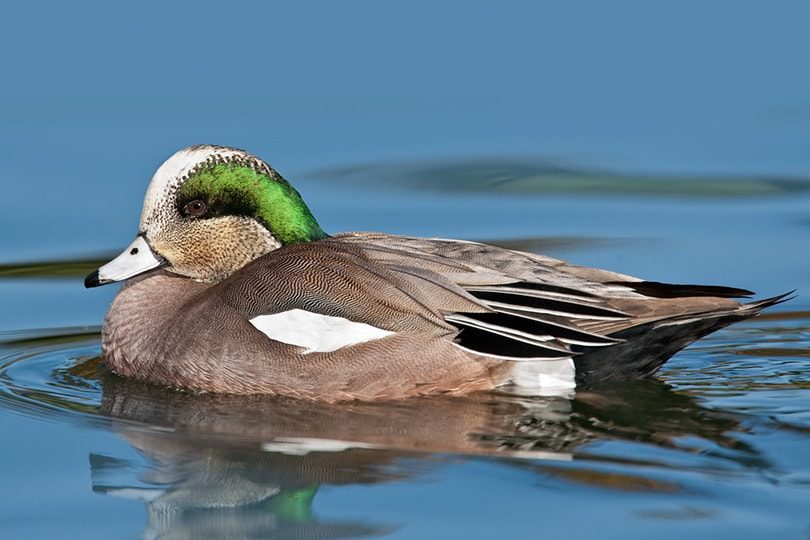
The American wigeon looks like a mallard duck. However, the green part of the head is just a band behind the eyes, unlike the mallard’s full green head. They have a short bill because most of their diet is plant matter. They will even go to nearby farms to feed on the fallen grain.
American wigeons prefer quiet lakes and marshes away from humans and will scare easily if you approach them. They are most likely to be seen in Massachusetts during the winter and migration season. The best way to find these ducks is to listen for them; males have a characteristic three-part whistle that sounds like a kazoo.
3. American Black Duck
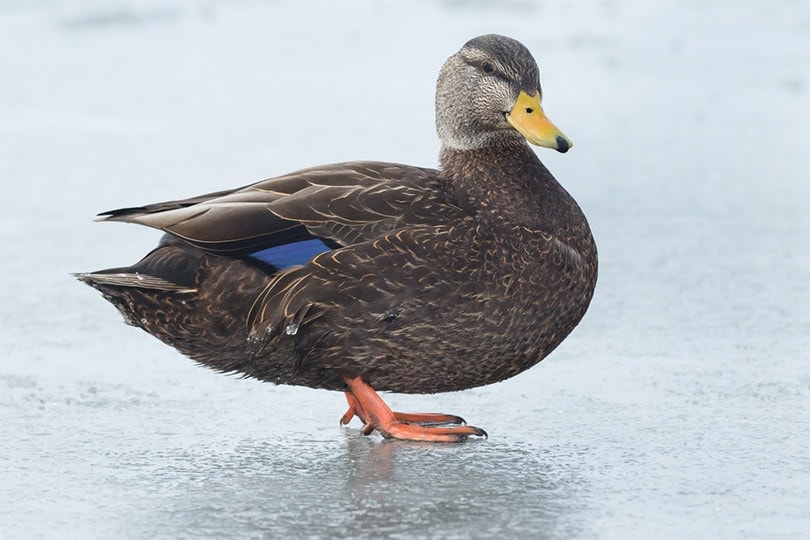
American Black Ducks are not black, but dark brown. The female American Black duck looks very similar to the female mallard duck, but her bill is a dull olive instead of brown and orange. When American black ducks fly, you can see an iridescent purple rectangle on their wings.
American Black Ducks often flock with Mallard Ducks. They can be found in Massachusetts year-round, and during the breeding season, males will make a loud whistle that sounds like a flute when trying to attract a mate.
4. Wood Duck
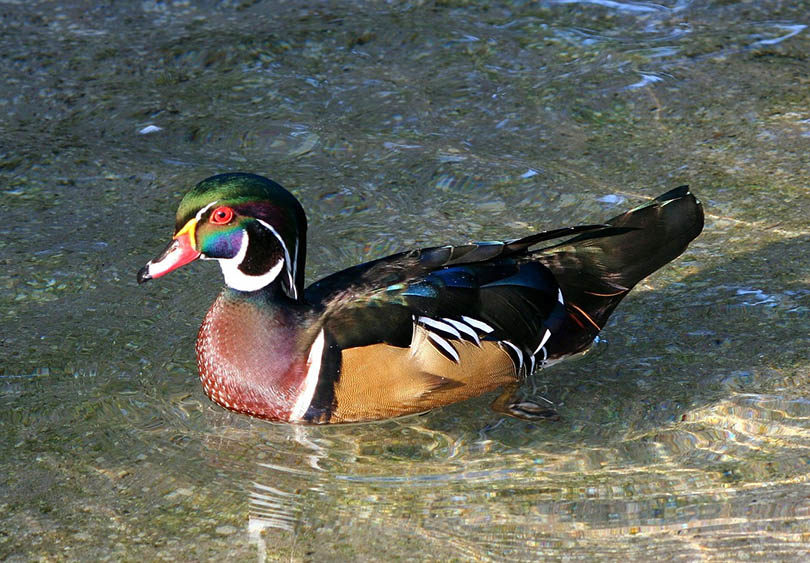
Male Wood Ducks have very intricate feathers. Male Wood Ducks have a green crested head and white neck; the breast is chestnut brown with white flecks, and the wings are a complex black, white, and brown pattern. Male Wood Ducks can be identified by their striking red eyes as well. Female wood ducks the slightly crested head with a white teardrop pattern on the eye and a blue patch on their wings.
Wood ducks can be found year-round in Massachusetts and prefer elevated tree cavities as their nesting habitat. However, they will readily use elevated birdhouses if offered.
5. Gadwall

Gadwall ducks can be easy to overlook because of their neutral appearance. Even though they may not be as striking as the Wood Duck, Gadwall Males have an intricate feather pattern. Their feathers are white-tipped, which gives them the appearance of being scaled. Females look similar to Mallard ducks and share the mottled brown, dark brown appearance. However, Gadwall Females have a white patch on the wings that is visible when flying.
While submerged vegetation makes up most of their diet, Gadwall ducks will sometimes steal food from diving ducks when they reemerge from under the surface. This behavior is mainly seen during the summer when animal proteins make it more of their diet.

Diving/Sea Ducks
Diving depth dive below the water surface, submerging themselves entirely in the water to grab vegetation or chase fish. Because of their hunting tendencies, they have developed short, pointy, narrow wings that allow them to maneuver underwater. Because their smaller wings don’t generate the necessary power to take off directly from the water, they may be seen running along the water surface to gain the momentum to take off.
6. Hooded Merganser
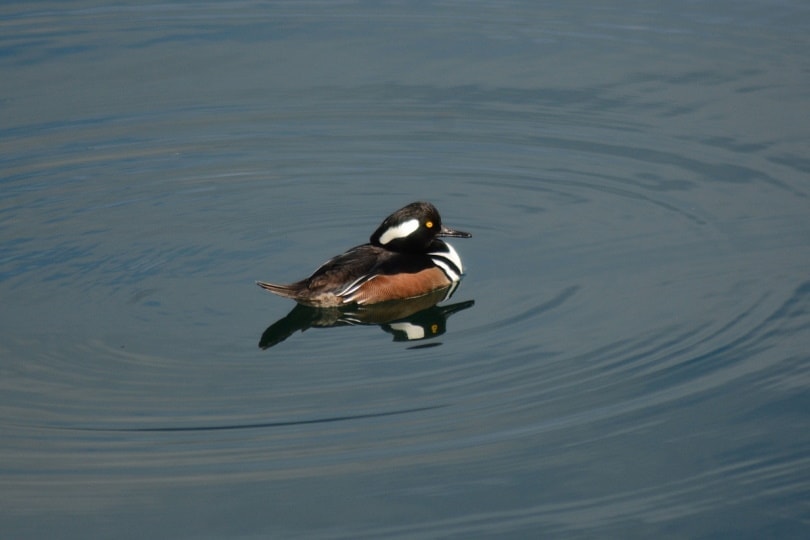
The Hooded Merganser can be found in Massachusetts year-round. These ducts stand out from the crowd, especially during the breeding season. Breeding males have an unmistakable black crest and a white patch behind the eyes. Females have a lighter-colored crest that looks like a Mohawk. Both sexes have an unmistakable long narrow beak.
You can find Hooded Mergansers in shallow ponds and rivers; however, you retreat to un-frozen lakes in winter. Their long, thin bill is serrated, which helps them catch and consume small fish and shellfish.
7. Lesser Scaup

The Lesser Scaup is the most common diving duck in North America. However, they can be hard to see because they gather in large lakes and estuaries. In the winter, Lesser Scaups gather by the thousands in the large lakes and have been described as like a patch of floating vegetation.
Male Lesser Scaups have a glossy black head, chest, and rear that contrasts with their silver-white wings. Females are brown with a darker brown head and a white patch near the bill. Both sexes feature striking yellow eyes.
8. Redhead

Redhead ducks are one of the friendliest ducks that you can find. Their outgoing and friendly nature makes them easily attractable with decoys and popular with game hunters.
Male Redhead ducks have a brownish redhead with a gray and black body, while female redhead ducks have an overall brownish coloring. Both sexes have a steep four head that dips down into their gray and black bill.
Female Redhead ducks practice brood parasitism which is where they will lay their eggs in the nests of other ducks and leave the chicks to be raised by the unknowing mother duck. Mallard and American widgeon ducks are common targets for the female Redhead’s brood parasitism.
9. Ruddy Duck

Ruddy ducks have an unmistakable appearance. Breeding males have a bright blue bill that makes them hard to mistake. Breeding males also have a white cheek black band on the back of the head and reddish-brown wings.
Ruddy ducks have unique mating rituals; male Ruddy ducks will be their bill against their neck to create bubbles in the water to attract a female. After this, they make a clack that sounds somewhat like a belch. But we guess the ladies love it!
Ruddy ducks are also better swimmers than flyers. Ruddy ducks will usually duck underwater and swim away rather than fly away like other ducks when threatened by a predator.
10. Ring-Necked Duck

While you may think that the Ring-Necked duck would have an unmistakable ring around its neck, you probably will be able to see the ring. Ring-Necked ducks have a light brown ring of feathers around their necks. That is so translucent that it is not visible from any distance.
Male Ring-Necked ducks have darker coloring than their female counterparts, with a black head, body, and light gray sides. Female Ring-Necked ducks are brownish with a gray face and a little white around the eyes.
Unlike most diving ducks, Ring-Necked ducks inhabit shallow ponds rather than deep ones. They gather in large flocks of upwards of thousands of birds during the winter.
Ring-Necked ducks are prone to eating shotgun shells, making them highly susceptible to lead poisoning before banning lead rounds.
11. Harlequin Duck

Harlequin ducks can only be found in coastal Massachusetts waters during their non-breeding season. However, they are one of the most breathtaking and striking duck breeds to behold. Breeding males have intricate feather coloring, sporting a blue body with a white crescent on the face and rust-colored sides. Bold white spots on the front and neck accentuate their short bill.
Female harlequin ducks are primarily brown. However, they support the same striking white spot behind the eyes as males. Females also have a small white area behind the bill and paler color on the stomach.
The most exciting thing about Harlequin ducks is that they choose to live in very extreme conditions, by comparison to most other ducks. Harlequin ducks raise their young and fast-moving rivers and spend their winters on the coastal shores. They get a lot of wind.

Final Thoughts
Birdwatching is a fun activity, and Massachusetts has so many bird species to see throughout the varied biomes. There are so many birds that you can see throughout the year in Massachusetts as many birds stop there during the migrations. The enormous breadth of wetland and marsh biomes make Massachusetts a great stop to see wild ducks of all kinds!
See Also:
- 15 Types of Black Birds in Massachusetts (With Pictures)
- 10 Types of Ducks in Virginia (with Pictures)
Featured Image Credit: purplerabbit, Pixabay
About the Author Luxifa Le
Luxifa is a freelance writer with a passion for animal science and technology. She loves to share the world of animal science with people to help them make informed decisions for themselves and their pets. Knowledge is power and she loves to help everyone become the most informed they can be.
Related Articles:
Monocular vs Telescope: Differences Explained (With Pictures)
10 Types of Hummingbirds in Arkansas (With Pictures)
8 Types of Hummingbirds in Nebraska (With Pictures)
5 Types of Hummingbirds in Idaho (With Pictures)
3 Types of Hummingbirds in Mississippi (With Pictures)
8 Types of Hummingbirds in Kansas (With Pictures)
5 Types of Hummingbirds in West Virginia (With Pictures)
5 Types of Hummingbirds in Ohio (With Pictures)
